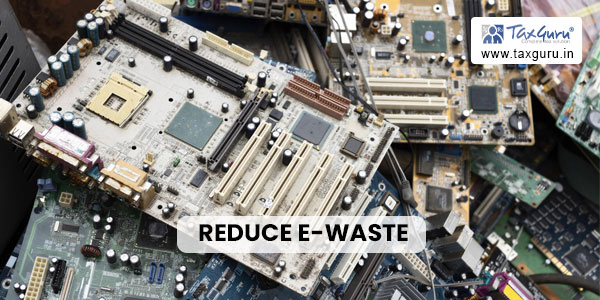Introduction: In our increasingly digital world, electronic devices have become an integral part of our lives. However, the rapid advancement of technology has also led to a concerning rise in electronic waste, commonly known as e-waste. E-waste comprises discarded electronic devices such as smartphones, computers, tablets, and televisions, which can be harmful to both the environment and human health if not handled properly. To address this growing issue, it is essential for individuals and societies to adopt sustainable practices that reduce e-waste generation and promote responsible electronic consumption. Some of the effective strategies to reduce e-waste and contribute to a cleaner, greener future.
Page Contents
Strategies to Reduce E-waste
- Extend the Lifespan of Electronic Devices: One of the most effective ways to reduce e-waste is to extend the lifespan of electronic devices. Consider the following practices:
- Take good care of your devices: Handle them with care, clean them regularly, and store them in appropriate conditions.
- Avoid unnecessary upgrades: Instead of constantly buying new devices, consider upgrading the components or repairing them when needed.
- Opt for durable products: Prioritize electronic devices known for their longevity and quality.
- Donate or Sell Usable Devices: When upgrading your electronic devices, consider donating or selling your old ones if they are still in working condition. This practice helps extend the device’s lifespan and provides an affordable option for individuals who cannot afford new electronics. Several organizations and online platforms facilitate the donation or sale of used electronics, making it convenient for both donors and buyers.
- Properly Dispose of E-Waste: When electronic devices reach the end of their useful life, it is crucial to dispose of them properly to prevent hazardous materials from seeping into the environment.

Follow these guidelines for properly disposing of e-waste:
- Recycle e-waste: Research local recycling facilities or electronic recycling programs that accept old devices. These facilities ensure that components are properly recycled or disposed of, reducing environmental impact.
- Use certified recyclers: When recycling, ensure that the recycler is certified and follows proper environmental and safety regulations.
- Dispose of batteries separately: Batteries contain toxic substances that can be harmful if not disposed of correctly. Find designated drop-off locations or recycling centers that accept batteries.
- Repair and Upgrade: Repairing and upgrading electronic devices can significantly reduce e-waste generation. Encourage repair services and support local technicians who specialize in fixing electronic devices. Additionally, many manufacturers offer repair programs or sell replacement parts, making it easier for consumers to extend the life of their devices.
- Responsible Purchasing: Make conscious choices when purchasing new electronic devices:
- Consider refurbished options: Refurbished electronics are often restored to near-new condition and offer a more sustainable alternative to brand-new devices.
- Research manufacturers’ sustainability practices: Prioritize companies that prioritize eco-friendly manufacturing processes, take-back programs, and promote recycling initiatives.
- Opt for modular designs: Devices with modular designs allow for easy component replacement, reducing the need to discard the entire device in case of a malfunction.
Reducing e-waste is crucial for several important reasons:
- Environmental Impact: E-waste contains hazardous materials such as lead, mercury, cadmium, and brominated flame retardants. When improperly disposed of in landfills or incinerated, these toxins can contaminate soil, water, and air, posing serious risks to ecosystems and human health. By reducing e-waste, we minimize the release of harmful substances into the environment, mitigating pollution and its detrimental effects.
- Resource Conservation: Electronic devices require valuable and often scarce resources to manufacture, including metals (such as gold, silver, copper, and palladium), rare earth elements, and fossil fuels. By reducing e-waste, we decrease the demand for new devices, thereby conserving these finite resources. Extending the lifespan of existing devices through repair, upgrade, and reuse helps optimize resource utilization and reduces the need for raw material extraction.
- Energy Consumption: The production of electronic devices consumes significant amounts of energy throughout their lifecycle, from raw material extraction to manufacturing, transportation, and disposal. By reducing e-waste, we indirectly conserve energy by reducing the demand for new device production. Additionally, recycling e-waste allows for the recovery of valuable materials, reducing the energy-intensive processes required for mining and refining raw resources.
- Landfill Space: E-waste occupies a considerable amount of landfill space, contributing to the growing global waste crisis. Landfills not only occupy vast areas of land but also emit greenhouse gases as organic materials decompose. By reducing e-waste, we alleviate the burden on landfills, promote efficient waste management practices, and help preserve natural spaces.
- Social and Economic Benefits: Reducing e-waste can have positive social and economic impacts. Donating or selling usable devices extends their lifespan and allows individuals who may not afford new electronics to access affordable technology. Moreover, the repair and refurbishment industry generates employment opportunities, contributing to local economies and fostering skill development.
- Global Responsibility: E-waste is a global issue that transcends borders. By reducing e-waste, we contribute to global sustainability goals and demonstrate a commitment to responsible consumption and production. Encouraging proper e-waste management practices also sets an example for other countries and promotes international collaboration in addressing this pressing environmental challenge.
Benefits of reducing E-waste
Reducing e-waste brings numerous benefits, which have positive impacts on the environment, society, and the economy. Here are some key benefits of reducing e-waste:
- Environmental Conservation: By reducing e-waste, we minimize the environmental impact associated with the disposal and production of electronic devices. This includes reducing the release of hazardous substances into the environment, such as heavy metals and toxic chemicals, which can contaminate soil, water, and air. Protecting ecosystems and minimizing pollution helps preserve biodiversity and ensures the health and well-being of both wildlife and humans.
- Resource Preservation: Electronic devices require the extraction of finite resources, including rare metals and minerals. By reducing e-waste, we extend the lifespan of existing devices, reducing the demand for new production and conserving valuable resources. This helps protect natural habitats, reduces the need for resource-intensive mining, and promotes sustainable resource management.
- Energy Efficiency: The production and disposal of electronic devices consume significant amounts of energy. By reducing e-waste, we indirectly conserve energy by minimizing the need for new device manufacturing. Additionally, recycling e-waste allows for the recovery of valuable materials, reducing the energy-intensive processes required for raw material extraction and refining. This contributes to overall energy efficiency and helps mitigate climate change.
- Waste Reduction: E-waste constitutes a substantial portion of global waste streams. By reducing e-waste, we alleviate the burden on landfills and waste management systems. This frees up valuable landfill space, reduces the need for incineration, and minimizes the environmental impacts associated with waste disposal. It also promotes the adoption of more sustainable waste management practices.
- Cost Savings: Reducing e-waste can result in cost savings for both individuals and businesses. Extending the lifespan of electronic devices through repair and reuse reduces the need for frequent replacements, saving money on purchasing new devices. Additionally, recycling e-waste allows for the recovery of valuable materials, which can be reused in manufacturing processes, leading to cost savings in the production of new devices.
- Job Creation and Economic Growth: Reducing e-waste can stimulate the growth of repair and refurbishment industries, creating employment opportunities and contributing to local economies. Repair technicians, recycling facilities, and refurbishment centers require skilled labor, leading to job creation and skill development. Furthermore, the recycling and circular economy sectors can contribute to economic growth by generating revenue from the recovery of valuable materials and the development of sustainable business models.
- Social Responsibility: Reducing e-waste reflects a commitment to responsible consumption and sustainable practices. It fosters a culture of environmental stewardship, raising awareness about the importance of proper waste management and inspiring others to adopt similar behaviors. By promoting responsible e-waste practices, individuals and organizations can contribute to positive social change and inspire collective action towards a more sustainable future.
Reducing E-waste as a measure for sustainable future
Reducing e-waste is a crucial measure for building a sustainable future. As the world becomes increasingly digitized and technology-driven, the responsible management of electronic waste becomes even more vital. Embracing sustainable practices to minimize e-waste generation offers several benefits that contribute to a more sustainable future:
- Conservation of Resources: Electronics manufacturing requires significant amounts of raw materials, including rare metals and minerals. By reducing e-waste, we conserve these valuable resources, extending their availability for future generations. This promotes a circular economy model, where materials are reused, refurbished, or recycled, reducing the need for continuous resource extraction.
- Climate Change Mitigation: The production and disposal of electronic devices contribute to greenhouse gas emissions. By reducing e-waste, we lower the demand for new manufacturing processes, which are energy-intensive and carbon-emitting. Additionally, recycling e-waste helps reduce emissions associated with extracting and processing raw materials.
- Minimization of Environmental Pollution: E-waste often contains toxic substances that can harm the environment, wildlife, and human health. By responsibly managing e-waste, we prevent hazardous materials from leaching into the soil, waterways, and air, reducing pollution and its adverse effects on ecosystems.
- Landfill Diversion: E-waste takes up valuable space in landfills, which are already under strain from increasing waste generation. By reducing e-waste, we decrease the pressure on landfills and promote more efficient waste management practices, such as recycling and proper disposal.
- Extended Product Lifespans: Emphasizing repair, upgrade, and refurbishment of electronic devices extends their lifespans. By maximizing the usability of these products, we reduce the demand for new devices and promote sustainable consumption patterns.
- Economic Opportunities: The reduction of e-waste creates economic opportunities in the repair, refurbishment, and recycling sectors. This leads to job creation, skill development, and the growth of green industries, contributing to a more sustainable and resilient economy.
- Social Equity: Reducing e-waste ensures that electronic devices become more accessible to individuals and communities with limited resources. Extending the lifespan of devices through repair and refurbishment provides affordable options for those who may not afford new electronics, promoting social equity and digital inclusion.
- Sustainable Consumption: By reducing e-waste, individuals and businesses practice responsible consumption. It fosters a culture of mindful purchasing, where the emphasis is on choosing durable, repairable, and eco-friendly products, leading to more sustainable consumption habits.
- Global Cooperation: E-waste is a global issue, and its management requires international collaboration. By reducing e-waste, countries and communities can work together to develop more effective recycling systems, share best practices, and address the global challenge of electronic waste collectively.
Conclusion:
Reducing e-waste is a collective responsibility that requires individual actions and systemic changes. By extending the lifespan of electronic devices, donating or selling usable devices, properly disposing of e-waste, supporting repair and upgrade services, and making responsible purchasing decisions, we can collectively reduce the environmental impact of electronic waste. Let us embrace sustainable practices and work towards a future where our digital lifestyle aligns with the principles of environmental conservation and responsible consumption.





